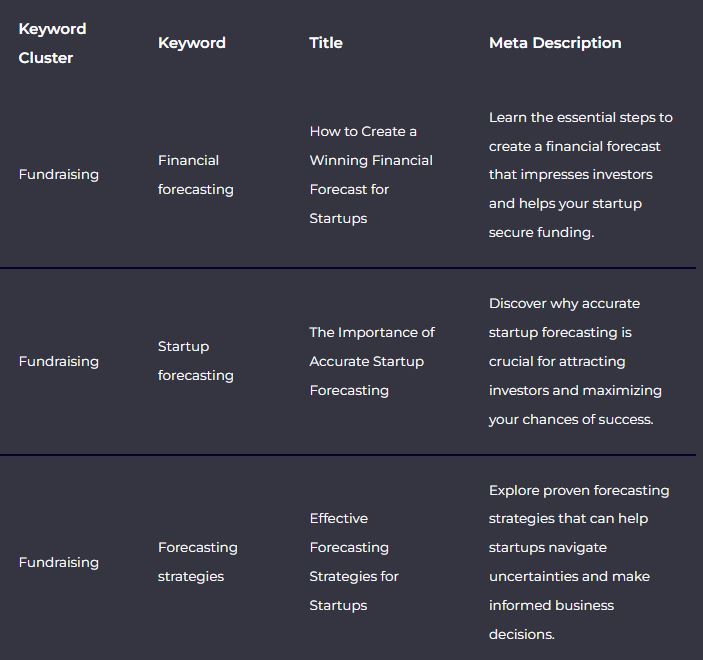SEO Keyword Strategist
Generate blog post titles, meta descriptions for cluster topics around a keyword or keyphrase
How it works
Plan your blog content using SEO keyword strategy. By using this generative AI tool you can quickly create a list of blog titles and meta descriptions based on a keyword or keyphrase.
SEO Keyword Strategist
Enter a keyword or keyphrase
ChatGPT may display incorrect or harmful information
Example output

Planning the Content of Your Blog Using SEO Keyword Strategy
Contents
- Introduction
- Why SEO Keyword Strategy Matters
- Understanding Your Target Audience
- Conducting Keyword Research
- Organising Your Content with Keyword Mapping
- Crafting Engaging and SEO-friendly Blog Titles
- Incorporating Keywords in Your Blog Content
- Optimising Your Meta Tags
- Creating Internal and External Links
- Monitoring and Adjusting Your SEO Strategy
- Conclusion
Introduction
Hey there! So you want to start a blog and get quality traffic to your website? Well, you’re in the right place. In this blog post, we’ll dive into the importance of planning your blog content using SEO keyword strategy. Whether you’re a seasoned blogger looking to enhance your SEO skills or a beginner eager to learn the ropes, this guide will provide you with the tools and insights to boost your blog’s visibility and attract your target audience. So grab a cuppa and let’s get started!
Why SEO Keyword Strategy Matters
Before we delve into the nitty-gritty of planning your blog content, let’s take a moment to understand why SEO keyword strategy is crucial. Simply put, SEO (Search Engine Optimization) is the practice of optimising your website to rank higher in search engine results. And keywords play a vital role in this process.
By strategically incorporating relevant keywords into your blog content, you increase the likelihood of your website appearing in search results when users search for those specific terms. This drives organic traffic to your blog, resulting in more visibility, engagement, and potential conversions. So, by planning your content around SEO keywords, you can attract quality traffic and reach your blogging goals.
Understanding Your Target Audience
The first step in planning your blog content is understanding your target audience. Who are they? What are their interests, needs, and pain points? Conducting thorough audience research helps you identify the topics and keywords that resonate with your readers.
Start by creating buyer personas to represent your ideal audience segments. Consider their demographics, preferences, and challenges. Then, use tools like Google Analytics to gain insights into your existing audience’s behaviour and preferences. This data will guide you in tailoring your content to meet their needs and preferences effectively.
Conducting Keyword Research
Once you have a clear understanding of your target audience, it’s time to conduct keyword research. This process involves identifying the keywords and phrases your audience is likely to use when searching for information relevant to your blog.
Begin by brainstorming a list of potential keywords related to your blog’s niche. Put yourself in your audience’s shoes and think about the terms they would use to find content like yours. Then, use keyword research tools like Google Keyword Planner, SEMrush, or Ahrefs to expand and refine your list.
Look for keywords with a combination of high search volume and low competition. These are the golden nuggets that will give you the best chance of ranking well in search results. Additionally, consider long-tail keywords, which are more specific and have less competition, allowing you to target a niche audience effectively.
Organising Your Content with Keyword Mapping
Now that you have a comprehensive list of keywords, it’s time to organise your content using a keyword mapping strategy. Keyword mapping involves assigning relevant keywords to specific pages or blog posts on your website.
Start by categorising your keywords based on their relevance to different topics or themes. Then, allocate these keywords to specific blog posts or pages that align with their respective topics. This mapping process ensures that you cover a wide range of relevant keywords across your blog, helping search engines understand the purpose and relevance of each page.
Crafting Engaging and SEO-friendly Blog Titles
Your blog titles play a crucial role in attracting readers and search engines alike. A well-crafted title not only grabs attention but also includes relevant keywords for SEO purposes.
When crafting blog titles, keep them concise, clear, and compelling. Aim to include your target keyword towards the beginning of the title to improve its visibility in search results. Avoid generic titles and opt for something unique, intriguing, and tailored to your audience’s interests. Remember, your title is your blog’s first impression, so make it count!
Incorporating Keywords in Your Blog Content
Now that you have an organised keyword mapping strategy and captivating blog titles, it’s time to start writing your blog content. As you create your posts, remember to incorporate your target keywords naturally throughout the text.
Avoid keyword stuffing, which refers to the excessive and unnatural use of keywords in an attempt to manipulate search rankings. Instead, focus on producing high-quality, informative, and engaging content that naturally includes your keywords. This approach not only enhances the reader’s experience but also signals to search engines that your content is valuable and relevant.
Optimising Your Meta Tags
Meta tags are snippets of HTML code that provide information about a webpage’s content to search engines. Optimising your meta tags can significantly improve your blog’s visibility in search results.
Ensure that your meta title and meta description accurately and concisely describe the content on each page. Include your target keyword in the meta title and meta description to increase its relevance and visibility. Remember, meta tags are often the first thing users see in search results, so make them enticing and informative to encourage clicks.
Creating Internal and External Links
Link building is a fundamental aspect of SEO that helps search engines understand the relationships between different webpages and improves your blog’s authority and credibility.
Internally, link relevant blog posts to each other to establish a logical and coherent structure within your website. This not only helps readers navigate your content but also allows search engines to crawl and index your pages more efficiently.
Externally, strive to acquire high-quality backlinks from reputable websites within your niche. This demonstrates to search engines that your blog is a reliable and valuable source of information. Reach out to other bloggers, participate in guest posting opportunities, and engage with your industry’s online community to build these valuable external links.
Monitoring and Adjusting Your SEO Strategy
As you implement your SEO keyword strategy, it’s crucial to monitor your progress and adjust your approach as needed. Tools like Google Analytics and Google Search Console can provide valuable insights into your website’s performance, including traffic sources, keyword rankings, and user behaviour.
Regularly review your keyword rankings and organic traffic to identify areas for improvement. Experiment with different keywords, content formats, and promotional strategies to optimise your blog’s performance. SEO is an ongoing process, so be prepared to adapt your strategy based on the ever-evolving search landscape and your audience’s changing preferences.
Conclusion
Planning your blog content using SEO keyword strategy is a powerful way to attract quality traffic and achieve your blogging goals. By understanding your target audience, conducting thorough keyword research, and organising your content effectively, you can optimise your blog for search engines and provide valuable and engaging content for your readers.
Remember, SEO is not a one-size-fits-all approach. Continuously monitor and adjust your strategy based on data and user feedback to stay ahead of the curve. With dedication and persistence, your blog can become a valuable resource, attract a loyal audience, and achieve the success you envisioned.

Leave Feedback
We would love to hear what you think. If you find any issues or have any suggestions of what would make the experience better for you, let us know.